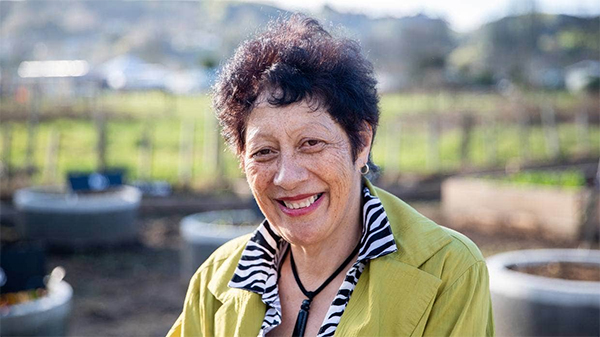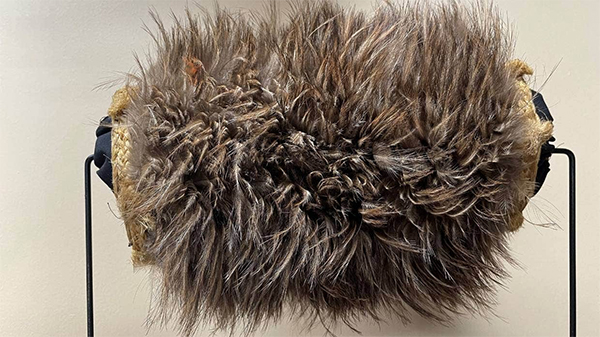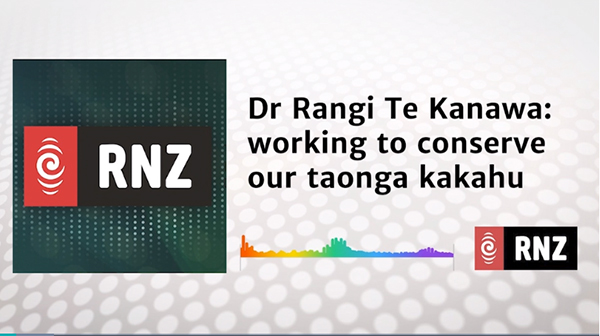A “mysterious” muff, or hand warmer, made from kiwi feathers and believed to be from the 1880s, at Marlborough Museum. Source: Marlborough Museum.
Jody O’Callaghan, Weaving expert walks in as museum starts research into ‘mysterious’ kiwi feather muff, Stuff, 30 November 2022
It was a moment of serendipity when a weaving expert walked in just as a “mysterious” Victorian-era kiwi muff was being walked across a provincial museum.
Master weaver Dr Kahutoi Te Kanawa was visiting Marlborough Museum with a friend to find a heitiki and her own whakapapa connections to the area when she saw the muff being carried past.
Staff had opened the glass case for the first time in a long time to photograph it to send away to an expert for research help, before realising the renowned weaving expert was in the building.
“I just happened to walk in at the right time, I couldn’t believe it. It was just fate,” Te Kanawa said.
“It was almost like the taonga was saying, ‘Oh, hang on just wait …”
She told them about how the muff – a feathered hand warmer – was put together and why it was made that way.

While the items were a Pākehā concept, they would have had to draw upon Māori weaver’s knowledge, to treat the kiwi skin – which is leathery and has to be softened like hides – and join the kiwi pelts together using muka (flax fibre).
“The feathers fall naturally and join together, that’s where weavers come into it,” she said.
Te Kanawa, who was in Blenheim consulting Ngāti Rarua Whenua Trust on embellishments for its whare, is a granddaughter of Dame Rangimarie Hetet (1892-1995) and daughter of Diggeress Te Kanawa (1920-2009) who were regarded as New Zealand’s finest traditional Māori weavers of the modern era.
She also happens to be the Pou Ārahi curator, Māori at Auckland Museum.

Marlborough Heritage Trust executive director Steve Austin said it was “wonderful” that Te Kanawa turned up right at that moment.
“Here I am in little provincial New Zealand and the universe provides.”
Staff recently discussed the muff at Omaka Marae, which fuelled efforts to focus on the taonga with experts in the coming months – to research, document and conserve it.
Te Kanawa was able to confirm the muff was a South Island taonga, partly based on the inclusion of a “signature” red kea feather, from the underside of a kea wing.

Austin believed the “mysterious” and beautiful muff had been in the museum since the 1950s, but was likely made in the Victorian period of about 1880.
”By the 1890s, exotic feathers were very fashionable among Pākehā.
”You know it’s something rare and precious when you see it.”
Little black cotton threads suggest it once was lined with silk that had since eroded away.
The feathers are so delicate, the muff is suspended for display to avoid flattening them.

Meeting Te Kanawa was “such a blessing”, Austin said, and they were excited to also get the help of her sister, Dr Rangi Te Kanawa, who would soon visit to conserve a precious early kahu kiwi (kiwi feather cloak).
“[The Te Kanawas] are the world experts and are such rare treasures in themselves.
“With perpetually constrained resources and the politics of heritage funding, the serendipitous visit was one of genuine heartfelt encouragement for all we try to do to ensure the taonga inspire future generations.”
To conserve pieces like it so that future generations could see them, museums needed to use knowledge of science of conservation techniques and tikanga Māori, Austin said.
The muff is on display at Marlborough Museum until February 2023 as part of our Fashion 1870 – 1970: Celebrations and Traditions exhibition.


